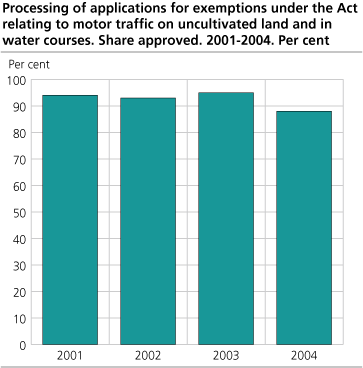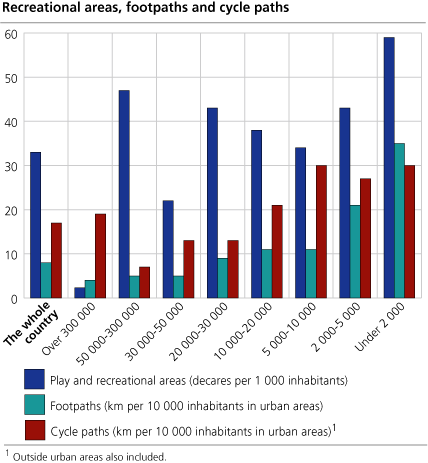Content
Published:
This is an archived release.
Stricter policy for traffic in uncultivated areas
Norwegian municipalities approved 88 per cent of the applications for motor traffic in uncultivated areas in 2004. This is a decline from 95 per cent in 2003. The number of applications is not evenly distributed between the municipalities, but this has little effect on the share of exemptions granted.
Motor traffic in uncultivated areas is banned in principle. However, under the Motor Traffic and Environment Act, local government authorities may grant exemptions from this rule and allow motor traffic for certain purposes. No data on actual traffic are available, but KOSTRA provides information on exemptions granted by local government authorities. Although the proportion of applications approved fell from 95 to 88 per cent, the number of exemptions still was higher in 2004 than in 2003 due to an increase in applications. The number of applications rose from 14 000 in 2003 to 18 000 in 2004.
In addition to the legal traffic, there is also illegal driving in uncultivated areas. In 2004, 436 violations of the Motor Traffic and Environment Act were reported. Over the last decade, this figure has varied between 400 and 500.
Municipal land conservation
The conservation of areas for environmental purposes is generally regulated by legal acts administered by the central government. But the Planning and Building Act gives municipalities the opportunity to protect areas of special value against development.
In 2004, 224 plans that include protection of cultural heritage and 43 plans that include areas of nature conservation were adopted. As around 2573 plans were adopted in total, this means that about 10 per cent of all plans adopted in 2004 contain environmental protection.
Recreation in urban areas
Almost 80 per cent of the Norwegian population live in urban areas. Urban land comprises only 0.7 per cent of the total land area, and, consequently, there are many and different interests connected with these areas. Access to green areas in the neighbourhood is therefore, to a large extent, dependent on whether such areas are secured in municipal land use plans.
The KOSTRA reporting shows that the average size of recreation areas per inhabitant is highest in the smallest and largest municipalities (except Oslo). In general, smaller municipalities have the best access to footpaths and cycle paths (see figure). When we take into consideration that access to other green areas is normally better in smaller municipalities, this indicates that it is particularly important to protect recreation areas in larger municipalities.
See also: Land use planning in municipalities and counties, 2004
Tables:
- Table 1 No. of plans relating to municipal preservation of cultural heritage and protection of nature
- Table 2 Processing of applications for exemptions under the Act relating to motor traffic on uncultivated land and in water courses
- Table 3 Recreational areas, tour and biking tracks
- Table 4 Municipal expenses, income and investments within recration in urban areas (function 335) and nature management and outdoor recreation (function 360). NOK 1 000
- Table 5 Municipal expenses, revenues and investments within protection of cultural heritage (function 365). NOK 1 000
- Table 6 Gross operating expenses, operating revenues and investments in outdoor recreation (function 716). County authorities. NOK 1 000
- Table 7 Gross operating expenses, operating revenues and investments in cultural heritage (function 750). County authorities. NOK 1 000
Find more figures
Find detailed figures from Environmental management in local and county authorities
Additional information
Contact
-
Ingeborg Hauge
E-mail: ingeborg.hauge@ssb.no
tel.: (+47) 95 87 66 56
-
Jørn Kristian Undelstvedt
E-mail: jorn.kristian.undelstvedt@ssb.no
tel.: (+47) 94 50 68 64


